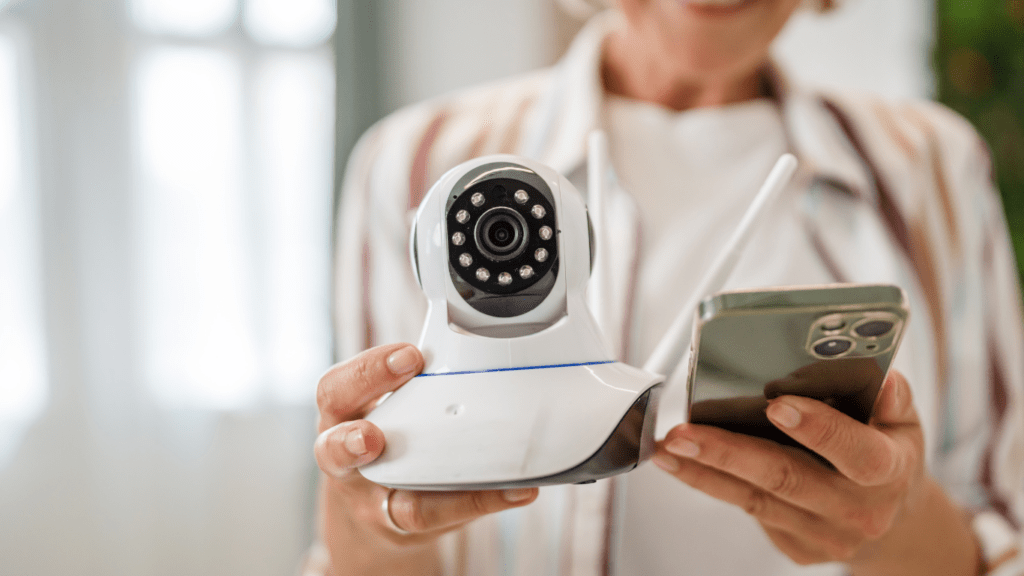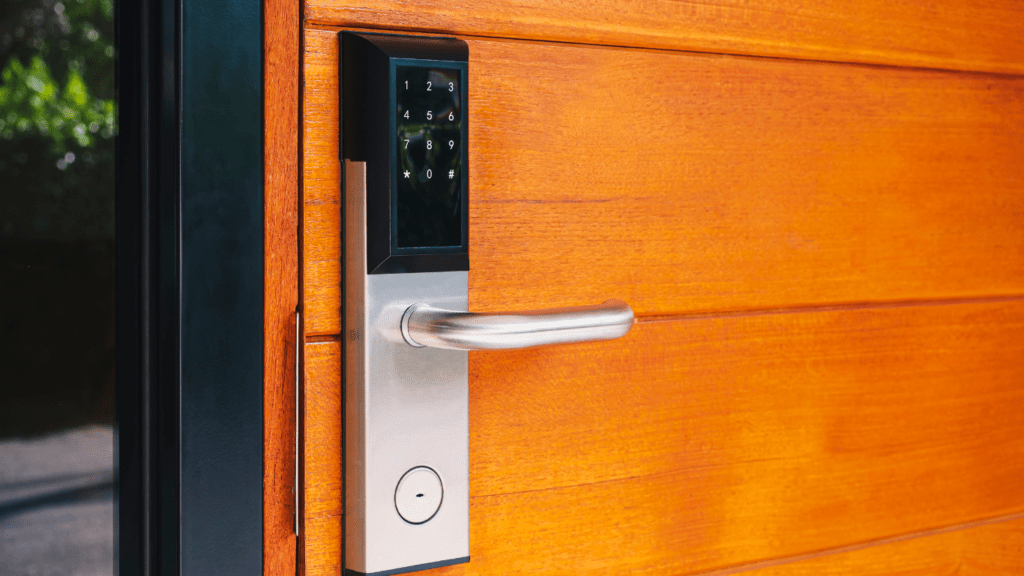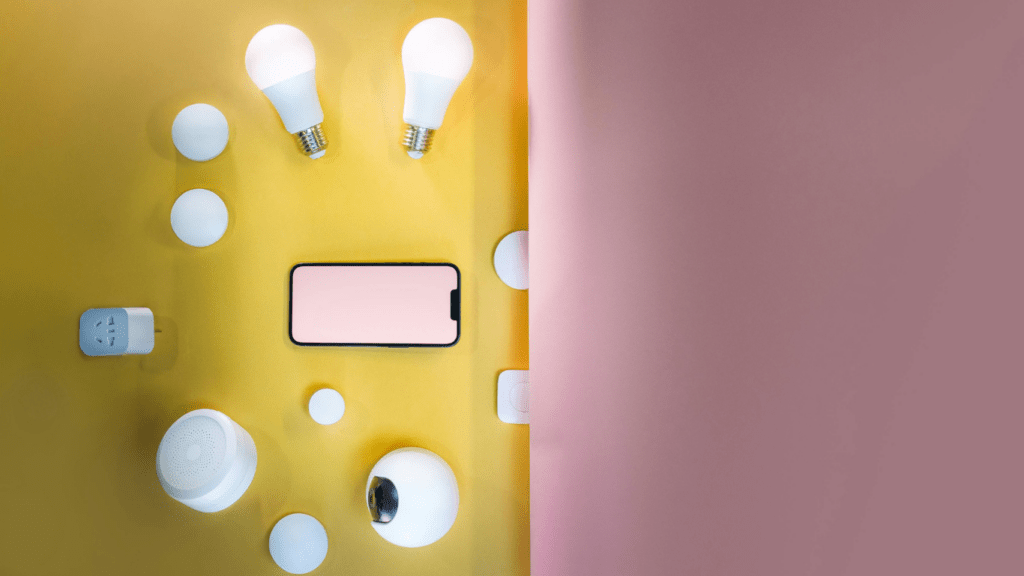Understanding Smart Home Security
Smart home security involves integrating various advanced devices and technologies to safeguard residential spaces. These systems use the internet to connect devices like:
- cameras
- locks
- sensors
allowing seamless monitoring and control from a smartphone or other smart device. The primary goal is to enhance safety through convenience and real-time alerts.
Components Of A Smart Home Security System
- Smart Cameras: These devices capture high-definition video, often with night vision, providing clear images day and night. For example, the Nest Cam offers live-streaming, motion detection, and two-way audio.
- Intelligent Locks: These locks allow remote access control, eliminating the need for physical keys. The August Smart Lock lets users lock and unlock doors via a smartphone app and monitors access history.
- Motion Sensors: These sensors detect movement within specified areas, triggering alerts if unexpected activity occurs. The Ring Motion Detector offers customizable motion zones and pet-friendly settings.
- Smart Alarms: These alarms integrate with other smart devices to provide comprehensive security alerts. The SimpliSafe system notifies users of break-ins, fire, and water damage through connected devices.
Benefits Of Smart Home Security
- Remote Monitoring: Users can view live footage and receive alerts from anywhere. This feature is vital for checking on pets, kids, or elderly family members when away from home.
- Real-Time Alerts: Immediate notifications allow for quick responses to potential threats. Systems like Arlo provide instant alerts through their apps, enabling timely action.
- Automated Actions: Smart systems can perform automated tasks like locking doors or turning on lights based on specific triggers. For instance, the Yale Assure Lock can lock itself automatically when it detects an authorized device leaving the home.
Choosing The Right Devices
Selection hinges on various factors, including budget, compatibility, and specific security needs. It’s crucial to choose devices that integrate seamlessly with each other and with any existing home automation systems. For example, if using an Amazon Alexa ecosystem, the Ring Video Doorbell integrates efficiently, providing effortless control through voice commands.
Benefits of Smart Home Security Systems
Smart home security systems offer many benefits enhancing safety and convenience. These systems don’t just protect your home, they simplify your daily life.
Convenience and Automation
Smart home security systems provide significant convenience. Automated schedules, remote control, and voice commands streamline security management. For instance, I can lock my doors, turn on lights, and arm the security system with simple voice commands or app controls. Automation routines like adjusting lighting or activating alarms when motion is detected save time and ensure my home remains secure even when I’m busy.
Real-Time Monitoring
Real-time monitoring allows me to keep an eye on my home at any moment. Smart cameras and sensors provide live video feeds and instant alerts on potential threats. For example, I’ll receive a notification if a door opens unexpectedly or if motion is detected when no one is home. Real-time data enables immediate action, minimizing risks and enhancing peace of mind.
Integration with Other Devices
Smart home security systems seamlessly integrate with other smart devices, creating a cohesive ecosystem. For instance, my security cameras, intelligent locks, and smart thermostats work together. When the system detects an issue, it can trigger actions like locking doors or recording video. Integration not only optimizes functionality but also enhances overall security, making my home more responsive and adaptive to various situations.
These benefits make smart home security systems an invaluable addition to any modern home.
Essential Smart Home Security Gadgets

Smart home security gadgets offer advanced protection, making homes safer and more secure. Here are key gadgets to consider for an effective security system.
Smart Cameras
Smart cameras provide high-definition video surveillance, enabling real-time monitoring. They feature motion detection and night vision. For example, Arlo Pro and Nest Cam offer cloud storage and integration with other smart devices. Remote access via smartphones enhances the ability to check on homes anytime, anywhere.
Smart Door Locks
Smart door locks offer keyless entry and remote access. They enable convenient locking and unlocking through smartphones. Popular models like August Smart Lock and Yale Assure Lock provide features such as virtual keys and auto-lock functions. These locks enhance entry security and simplify access management.
Video Doorbells
Video doorbells combine camera and intercom functions for enhanced entry monitoring. They offer real-time video feeds and two-way communication. For instance, Ring Video Doorbell and Google Nest Hello allow users to see and talk to visitors from their smartphones. Motion detection alerts further improve security by notifying users of any approaching activity.
Motion Sensors
Motion sensors detect movements within designated areas. They integrate with other devices to trigger specific actions. Examples include Philips Hue Motion Sensor and Samsung SmartThings Motion Sensor. These sensors enhance security by activating lights, alarms, or cameras when movement is detected, deterring potential intruders.
Smart Alarms
Smart alarms feature real-time alerts and integration with other security devices. They notify users via smartphones about security breaches. Popular options like SimpliSafe and ADT Pulse offer customizable settings and professional monitoring services. These alarms provide comprehensive protection by immediately alerting users to any threats, enabling quick responses.
Installation and Setup Tips
Proper installation is key to getting the most from smart home security gadgets. Follow these tips to streamline the process.
Smart Cameras
Positioning smart cameras in strategic locations is essential. High-traffic areas like entry points and hallways benefit most from surveillance. Install cameras at a height to avoid tampering while ensuring broad coverage.
Smart Door Locks
Installing smart door locks requires aligning the lock with existing deadbolt pre-drilled holes. Ensure compatibility by checking the lock’s retrofit requirements. Use the manufacturer’s installation guide to avoid common mistakes.
Video Doorbells
Mount video doorbells at eye level for optimal facial recognition. Ensure Wi-Fi signal strength is adequate by testing connectivity at the installation point. Use mounting brackets if needed for a secure fit.
Motion Sensors
Place motion sensors in corners and at entry points to maximize coverage. Mount sensors at a height of about 6-8 feet to enhance detection range. Avoid placing them near heat sources or direct sunlight to prevent false triggers.
Smart Alarms
Install smart alarms in accessible but inconspicuous locations. Pair them with other smart devices during setup to integrate into the home security system. Use the app to configure preferences and test connectivity.
Properly installed and configured smart home security gadgets enhance overall efficiency and effectiveness, contributing to a safer living environment.
Evaluating Security Gadgets
When assessing smart home security gadgets, it’s critical to evaluate specific criteria to ensure optimal protection.
Ease of Use
Ease of use significantly impacts the effectiveness of security gadgets. Devices featuring intuitive interfaces, such as user-friendly mobile apps and straightforward setup processes, tend to be more beneficial. For example, smart cameras with simple WiFi connectivity and smart locks with seamless smartphone integration offer an enhanced user experience. Moreover, gadgets supporting voice commands via digital assistants like Alexa or Google Assistant add to the ease of use.
Reliability
Reliability is a fundamental factor when evaluating security gadgets. Gadgets from reputable brands often provide consistent performance which is essential for home security. I prioritize devices with high uptime, strong network performance, and robust build quality. For instance, smart cameras with reliable motion detection, smart locks that function correctly in all weather conditions, and motion sensors with minimal false alarms exemplify reliable security gadgets. Look for products with positive customer reviews and strong support from manufacturers.
Cost Effectiveness
Cost-effectiveness balances features, quality, and price. It’s essential to assess both initial investment and long-term costs when selecting security gadgets. While high-end smart cameras or intelligent locks from brands like Nest or Ring might incur higher upfront costs, their durability and advanced features can justify the expense. Evaluate prices, factoring in subscription fees for cloud storage or premium features when necessary. Opting for budget-friendly gadgets shouldn’t compromise critical functionalities, so ensure that even lower-cost options meet essential security requirements.
Evaluating security gadgets through these criteria—ease of use, reliability, and cost-effectiveness—enables informed decisions, ensuring an optimal blend of safety, functionality, and value.



 Founder & CEO
Irenee Nunezerro is the visionary founder and CEO of Luxe House Maker, with over 15 years of experience in luxury real estate and interior design. Known for her expertise in blending opulence with innovation, Irenee launched Luxe House Maker to provide readers with comprehensive updates on the latest trends in high-end properties, interior décor, and smart home technology. Her passion for creating luxurious, technologically advanced spaces has positioned Luxe House Maker as a leading resource for those seeking to elevate their lifestyles. Irenee’s commitment to delivering cutting-edge content ensures that Luxe House Maker stays at the forefront of the luxury market.
Founder & CEO
Irenee Nunezerro is the visionary founder and CEO of Luxe House Maker, with over 15 years of experience in luxury real estate and interior design. Known for her expertise in blending opulence with innovation, Irenee launched Luxe House Maker to provide readers with comprehensive updates on the latest trends in high-end properties, interior décor, and smart home technology. Her passion for creating luxurious, technologically advanced spaces has positioned Luxe House Maker as a leading resource for those seeking to elevate their lifestyles. Irenee’s commitment to delivering cutting-edge content ensures that Luxe House Maker stays at the forefront of the luxury market.
